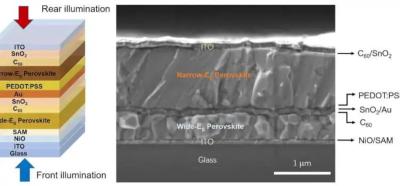A team of scientists, led by Professor Hairen Tan of Nanjing University, has demonstrated (for was the team states is the first time) bifacial all-perovskite monolithic tandem solar cells and examined their output power potential.
The research team demonstrated the design and fabrication of bifacial all-perovskite tandem solar cells using transparent conductive oxide (TCO) as the back electrode. The bandgap technique of the top subcell was used to obtain current matching under different backlights. The influence of the albedo on the photovoltaic parameters and the spectral sensitivity was systematically investigated. The bifacial tandems reportedly showed a high output power density of 28.51 mW cm−2 under a realistic rear illumination (30 mW cm− 2). Further energy yield calculation showed substantial energy yield gain for bifacial tandems compared with the monofacial tandems under various ground albedo for different climatic conditions. This work provides a new device architecture for higher output power for all-perovskite tandem solar cells under real-world conditions.
The bifacial monolithic all-perovskite tandems were demonstrated using transparent back electrodes. This allows for the harvesting of light hitting the back of the tandems. The bifacial tandems showed a more significant increase in performance than the monofacial tandems. Only the top subcell bandgap was adjusted to achieve the current fit of backlit bifacial tandems, which was valid for albedo below 40%. At albedo above 40%, the current density of the tandems is saturated. The researchers proposed further reducing the bandgap of the top subcells or increasing the bandgap of the bottom subcells.
Using ALD-deposited SnO2 and sputtered transparent line oxide (ITO) as back contacts can avoid halogen corrosion of the back electrodes. Reducing the bromide content in the top cell can reduce halide segregation. Bifacial tandems showed significant energy yield gain under real conditions with different presensive soils and different climatic conditions. Since the bifacial all-perovskite tandems aim to harvest light at the backside to enhance OPD, they are expected to be applicable at utility scale.
Researchers found that their all-perovskite bifacial tandem fabricated on a lattice glass substrate could also be processed on a flexible all-perovskite tandem bifacial substrate. Climatic conditions and terrain directly affect the intensity and range of albedo. Custom bifacial tandems with different upper subcell band gaps are required for different climates and soils. The solar tracking technique will attract bifacial tandems to take advantage of the albedo. This work demonstrates the potential of bifacial all-perovskite tandems as a new device architecture for higher output power with improved stability.
